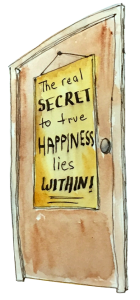Have you ever noticed that you and your partner keep having essentially the same fight over and over again?
No matter what the topic, whenever you get into an argument, does it always seems to turn out the same way? That’s usually because you are shadowboxing with the wrong person.
Let me introduce you to the six people in your relationship.
#1: You, when things are going along fine between you .
#2: Your partner when things are going along fine between you.
#3: How you see your partner when he/she has pushed one of your emotional buttons.
#4: How your partner sees you when you have pushed one of his/her emotional buttons.
#5: How you see yourself when your partner has pushed one of your emotional buttons.
#6: How your partner sees him/herself when you have pushed one of his/her buttons.
What emotional buttons inside of you is your partner pushing?
You might have noticed this all boils down to how we react to when one of our emotional buttons gets pushed. Unfortunately, most of us are unaware of our internal emotional wiring and how and why we are getting triggered. We prefer to think the problem is always our partner’s fault. So, we end up trying to get our partner to change his/her behavior. Instead, consider looking within yourself. Seek to understand how and why you react as you do. What exactly is making you angry, defensive, or feeling misunderstood.
Stop blaming your partner and do your inner work.
Stop blaming each other and start decoding your inner dynamics. This will put you on the road to significantly improving the health and well-being of your relationship.
Let current button pushing show you where you need to heal leftover hurts from the past that are being activated. Getting hot-headed and blaming each other will eventually drive you apart seeking seemingly greener pastures. Instead, how about embracing the opportunity to transform your relationship into a safe emotional haven for you both.
Here’s an example of the six people in action.
The following example might help you to recognize the six people in your marriage or partnership in action. Remember, most arguments seem really stupid when you replay them.
Meet Robin (#1) and Jack (#2). They are in love, have been dating about a year and are becoming disillusioned by their habitual fights. To make it easier to follow, I’m just going to present explanations of Robin’s behavior and leave Jack’s perspective (#4 and #6) to your imagination. Robin is a graphic designer and marketing expert and this is her first serious relationship.
A recent argument went as follows. Everything was just fine between them. Then, Jack told Robin he was planning to develop a new website. His plan was to lay out his vision of what he wanted. Then he would have his friend Chip do the graphic design work that would bring his vision to his website. Robin became incensed. Why didn’t Jack even consult her for her graphic design expertise? She began spinning reasons in her head about all the things that are “wrong” with Jack, fueling her upset. She got more and more angryas she told herself how “right” she was (#5) and how “wrong” Jack was (#3).
She condescendingly corrected him saying it would be Chip who created the vision – not Jack. Jack felt insulted that Robin thought he was not creative and would have no creative input in the design of his own website. Finally, Jack, running late for work, headed for the door. Robin was left in disbelief that he could just walk out like that.
Here’s the decoded version of what was really happening in the above scene. All was fine between them until Robin (#1) got triggered by several things that she misinterpreted about what Jack way saying. She took offense that here she was a graphic designer and loving partner (#5) and it didn’t occur to Jack to ask for her input. This reinforced her belief/fear that Jack didn’t value or respect her professional competence (#3). That’s the person she was fighting with.
I asked Robin to focus on the feeling she had when Jack first pushed her button. Then I asked her to trace it backward in her life. Where else had she felt that way? She immediately recognized this feeling being associated with her relationship with her older sister. A specific image came to mind of playing with their Power Rangers. Her sister always took the pink one and never even noticed or cared that Robin would have liked the pink one too. This had become a pattern in her life.
So, standing there with Jack, her sensitivity to being left out of consideration by another was the trigger. The old, unresolved emotions with her sister wereskewing and fueling the intensity of her reaction to Jack. Angry, she asserted her authority (#3) by correcting Jack’s description of turning over his designs to a graphic designer to execute. Jack, with his own sensitivity to believing that Robin didn’t think of him as having any creativity (#4), got angry and disgusted with her. He also felt that, as usual, she was making an issue where none existed. He headed for the door because he wanted to get away from her and this craziness.
Robin, outraged at his choice to leave at that moment, feared that he was leaving her forever. That was another childhood fear that was being triggered. She told me how her father used to storm out in disgust with her mother. As a child, she was always afraid her father would never return and thouht it was all her mother’s fault. With Jack gone, she began turning her anger on herself and blaming herself for pushing him away, afraid he would never return. Got the picture? Each one was having an entirely different experience and conversation – doing battle with figments of their imagination in the theater of their minds.
Get rid of your old emotional baggage.
This is common behavior between “normal” people who have not cleaned up their old emotional baggage. And inevitably, past baggage gets triggered in present relationships. So, what do you do? If you can afford it, I suggest getting a marriage counselor or mentor with a good sense of humor. Learn what your respective triggers are and how to deactivate them. This will allow you to approach your differences in a constructive, exploratory, and non-blaming way.
Alternatively, try to do this decoding on your own. The place to begin is always to turn your attention inward instead of outward. Shift from the blame game to truly healing and transforming the quality of your communication. It is important to realize that we each need to become intimately aware of how we are wired based on past experiences. Otherwise, it all runs on autopilot and runs amuck as in the example above.
If your partner is not willing to do this together, don’t let that stop you from pursuing your own inner work. He or she simply might not be as convinced or ready as you are. Take the lead. Do your part to take ownership of your own baggage. Discover how past hurts are creating current sensitivities. Once you start behaving differently – as in doing a different dance step — your partner will follow along eventually. When six people are fighting, no one is being heard.
If you would like to know more about me and my work, please explore my website here.






